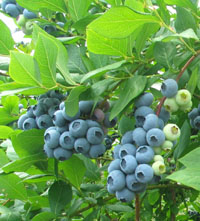UK Blueberry Variety Research
UK Blueberry Variety Research

For 10 years, eight varieties of Northern highbush blueberries have been evaluated at the University of Kentucky Research and Education Center in Princeton .
The research centered on productivity of these varieties including individual berry size, harvest dates and total production per plant. The berries were planted in 1993 and data collection began two years later.
The varieties have ranged in production from 15 to 22 pounds per bush which means 10 to 15 quarts per bush, said Joe Masabni, UK Extension fruit and vegetable specialist.
Peak harvest at the western Kentucky station is mid June, but blueberries can be planted so that harvest can be spread from June to September, if you pick the right varieties, he said.
“Blueberries are easy to grow because they are naturally resistant to a lot of diseases and insects,” Masabni said. “At Princeton , we’ve had very few problems except for birds and Japanese beetles. At UKREC, netting is used every year to protect the ripening berries from birds. Insecticides are used to keep the Japanese beetles under control.”
Prior to planting blueberries, growers need to have the proper soil pH. Blueberries prefer a soil pH of 4.5 to 5.2, so growers may need to amend the soil to make the environment suitable for planting.
Irrigation is necessary to establish and grow blueberry plants, he said. Plants grow best if planted on a ridge and mulched with pine.
With the berries now ripening, final data from the 10-year project is being collected but research on blueberries is far from over at the facility. Blueberries are increasing in popularity with consumers and are gaining interest with growers in the state.
To continue efforts in blueberry research at UKREC, new plantings of Southern highbush blueberries and rabbiteye blueberries have been planted. Research on these two species will involve seeing if they are adapted to Kentucky and include variety evaluation as well as weed control, Masabni said.
Southern highbush blueberries are crosses between rabbiteye and highbush blueberries. Most southern highbush varieties are better adapted to the south, because they are less hardy, have a shorter chilling requirement and bloom earlier than highbush.
The rabbiteye varieties generally are taller than the highbush varieties. Some rabbiteye varieties can get up to 14 feet tall, are very disease resistant and less hardy than highbush varieties.
It will be three years before harvesting will begin on these new varieties to allow the plants to become established.
“ Kentucky is under producing blueberries,” Masabni said. “So blueberries have an excellent potential for local consumption if not for export to other states.”
Masabni said growers in the state are offering both u-pick and already picked blueberries.
“There is good money in both,” he said.
To learn more about blueberry production and the results of UK blueberry variety trials at Princetonand other locations, contact a local office of the UK Cooperative Extension Service.
-30-
